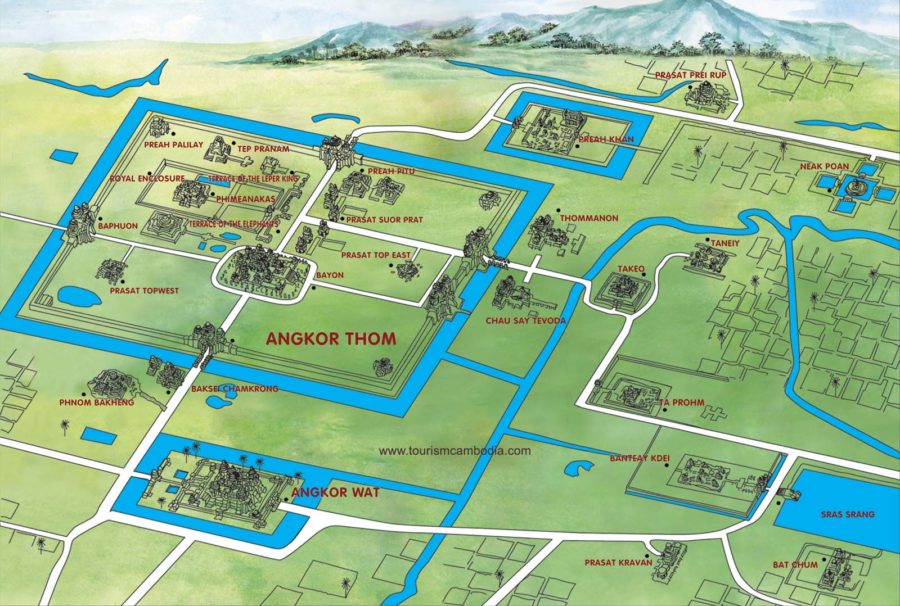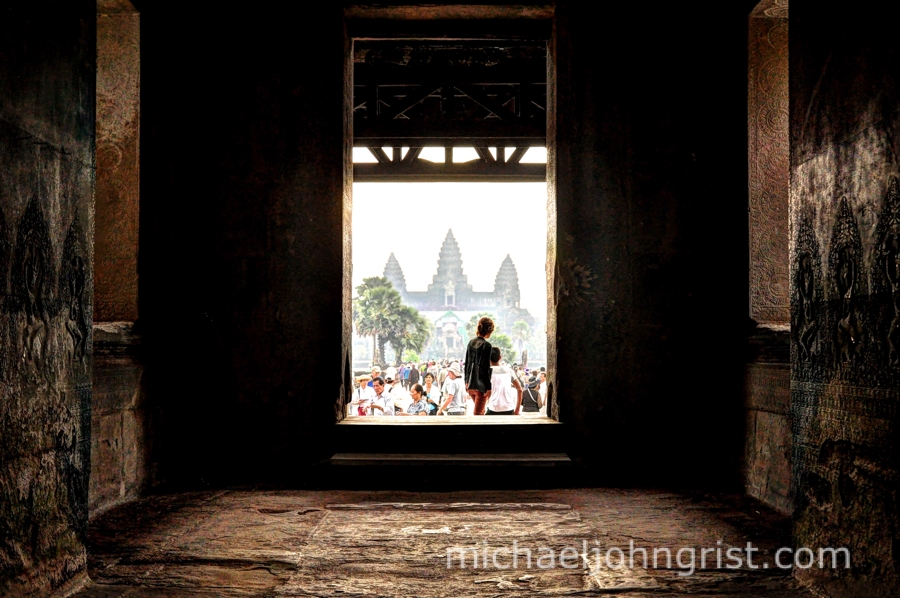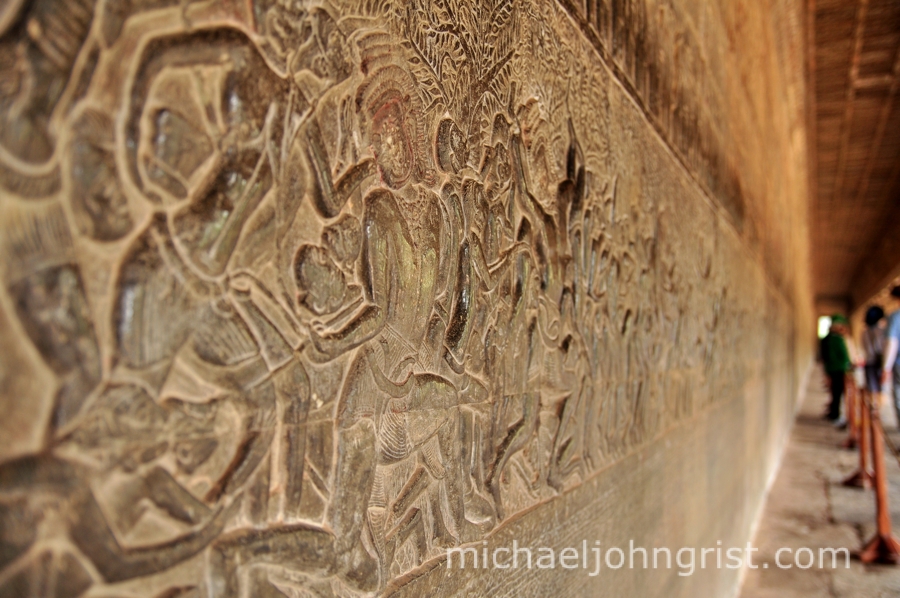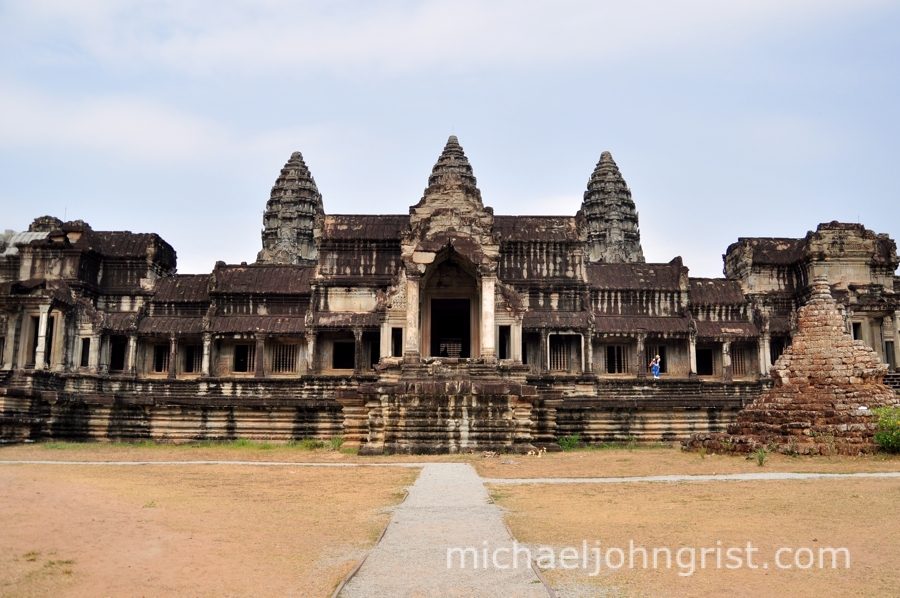Angkor Wat is the last, greatest remnant of the ancient Khmer empire, a sprawling citadel and temple complex built nearly 1000 years ago, now resplendent in ruins. Doubtless you’ve heard of it. It’s the biggest tourist attraction in Cambodia, with thousands of visitors parading through its grand porticoes every day, clad in day-glo Crocs and local-bought elephant-pattern pants, mooning over this relic of the Khmer’s grand vision.
A few weeks back my wife SY and I went to moon right alongside them.

Angkor Wat beyond the boundary moat.
We went to Angkor Wat as part of a whirlwind 9-day tour of Bangkok and Cambodia. We spent about half that time in transit- 2 days for flights there and back, plus 2 days spent crossing the Thai-Cambodia land border via buses, minivans, and tuk tuks. Three of the remaining days we spent on an exhilarating tour schedule at Angkor Wat, waking up at 5am to see sunrises, coming back with sunset heat-exhausted (April is high summer in both countries, up to 40 degrees C / 100F), seeing everything that we could.
It was fantastic. For three days we rambled amongst the rubbled and overgrown temples of the Khmer empire, getting lost in myth and trying to break clear of the tourist throngs whenever we could. It wasn’t easy to get away from the masses though, not really accomplishable to the level I have in the past (where minor Japanese ruins likely go unvisited by anyone for months, if not years). Still, we hit a few spots off the beaten path (with dirt road access), walked a few routes not strictly laid-out for tourists to follow, and sated some primeval urge to do something a little adventuresome.
And of course we took photos along the way.

This is an HDR composite image, with the tourists fogged to ghosts. I quite like how they appear transient, while the Wat holds firm.
Angkor Wat means ‘city of temples’, and is frequently used to refer to all the temples in the vicinity of Siem Reap (the nearest town, whose name itself means-‘the flat defeat of Siem’, and ‘Siem’ means Thailand). However ‘Angkor Wat’ refers more precisely to one temple in particular, featuring a quincunx of towers like peaks in an ascending mountain range. It’s the largest temple of them all, with the biggest tourist draw, so it was tricky to get photos without people in.
All around Angkor Wat are lots of other temples. Nearby stands the huge Angkor Thom, enclosed by a massive wall, which is actually not a temple but a town. Inside it were lots of smaller temples, plus all kinds of other buildings, including the emperor’s palace. Nothing remains of the palace though, since the Khmer built it with wood, reserving stone for the homes of their gods.

This image from Tourism Cambodia gives you some idea of the two Angkor’s relative scale.
Angkor Wat is 500 acres in size.
Once we got buried in touring, going from vast construction to vast construction, the sheer wealth, scale, and pride of the Khmer empire came home to us repeatedly. This was a seriously rich empire, that left an indelible mark on the land. I read Angkor Wat itself was made of 5-10 million ‘bricks’, each weighing up to 3,300 pounds. Crazy. All of that had to be quarried, ferried down numerous canals dug for the purpose from a nearby mountain, dressed, then raised into place.
And that was just Angkor Wat.
It’s a stunning amount of stone. Like with most fallen civilizations, and Shelley’s immortal poem Ozymandius, it begs the question- How did they fall, if they were once so great? What happened?
I’m sure there are plenty of answers out there, probably a combination of over-population leading to over-use of water, desertification, with roaming barbarians to put the cherry on top (and cut the heads of all the statues). If you want to get into all that, I recommend Jared Diamonds book Collapse. But for me, the actual reason is less interesting now than the overwhelming feeling of loss/nostalgia/mystery/faded glory being there engendered.
It’s the same feeling I had in Pompeii, that I’ve written about before (here), and the same feeling I was chasing through numerous ruins all around Japan. The feeling that there are ghosts out there, with stories, who were powerful and mighty but who came up against some unseen force they could not defeat. So all their hubris turned to dust, and again we come back to Ozymandius’ ‘two trunkless legs of stone.’
OK enough of that for now. Some photos.

In the middle gatehouse, looking in.

You lay incense at this god’s feet.
We hired a guide for three days, Mr. Borey, who drove us around and suggested things to look at. He told us some of the history of the place too, which was fascinating. My favorite story was ‘The churning of the Sea of Milk.’ Do you know it?
It’s a Hindu origin myth. Set side-by-side with the origin in the bible’s Genesis, it really kicks a lot of ass. Of course it’s not a competition, but still. It’s actually a very important story to old Angkor, and was exemplified in stone just about everywhere you look. We’ll see the key creature from the story multiple times in these photos. But first, the carving-

Actually I think is the wrong carving, this being one of what heaven and hell looked like to the Khmers. Essentially quite a lot like a Christian version, with lots of torture in hell, and lots of slaves (except for the slaves) pampering you in heaven.
The carvings were huge, at least 60 meters long along the sides of various temples, maybe three meters tall. Here’s some art from the web-

Gods on the left, demons at right, Shiva turtle underneath and Shive man chilling on top, with fire-breathing Naga as rope.
Image from harekrsna.com
So what’s going on there?
The story is about the gods and the demons trying to get hold of the elixir of youth, so they can be all-powerful and live forever. It’s a special liquid found only at the deepest points of the sea of milk. Nobody can dive down to get it, it’s just too deep. So, like the mouse that churned the milk to butter to escape from the milk pail, they decided to churn it out.
The trouble was that the sea was big, and there was no whisk big enough. so they broke off a mountain and put it in the sea. Then they needed a rope to wrap around the mountain so they could spin it (like a spinning top), but there was no rope big enough. So they grabbed the world snake, Naga, and wrapped her around it. Then all the gods lined up on one side, the demons on the other, and so began the grandest bout of tug-of-war ever.
They churned the sea to bits. All the life in the sea got chopped up and spat out, including fish, whales, and people. At the center was Shiva, boss god, doing a dance. Finally they got the elixir, the gods drank it, happily ever after.
The key thing is the tug of war, and Naga. Rope-pullers and Naga are everywhere, lining roads, serving as balustrades, carved into walls. It’s an iconic image that repeats endlessly, everywhere (even in the Thai airport in Bangkok), the same way Christians have crosses with Jesus on.

This is the entrance to Angkor Thom (more on it in another post). At left and right are long lines of Naga-pullers.
? 
Naga’s broken head with Naga-pullers hoisting.
At Angkor Wat Naga was used as the promenade balustrade- and actually there signs warning people not to sit on Naga, because that would be disrespectful. We even got in trouble once, because we sat on a bit of stone we didn’t realize was another part of Naga, and a site warden came over and yelled at our tour guide. It’s not ‘Khmer’ to sit on Naga.
Soon we were inside.

This is inside the central five stacks. Probably these big squares would have been full of water.

The cloisters in HDR. Lots of monks were strolling around in orange robes.
Next was an ascent, up towards the central tower. The stairs were very steep, and led to the central biggest tower, itself surrounded by four more courtyards.

Pretty huge. This is actually a stitched image of two photos, because it was too big for my camera to see all of it.
Walking around Angkor Wat made me think about what has always fascinated me about ruins, and which ruins (haikyo) have been my favourites in Japan. Largely, I like the old ones, and the big ones. If they were associated with events in history in some way, all the better- like the military bases, the kaiten factories, the multi-million dollar theme parks. Anything writ on a large scale.
Of course I went to the minor haikyo as well- the hotels, strip clubs, homes, spas, and enjoyed them too. Sometimes I took photos of minutiae inside drawers, standing on shelves, etc.. But mostly I was out for the grand sweeps, the huge architecture. I loved Matsuo ghost town, lost in the fog, and the great blue slides of Sports World, overgrown in green. Huge old factories, grand old parks, places that dared to dream.
Angkor Wat is obviously cut from that same cloth, but to the nth degree. It also however damns me to a limited number of such ruins. There are only so many grand ruins, even modern ruins, available. If I had the money, I could travel all round the world and take in all kinds of relics from World War 2, the cold war, economies in collapse. That would be pretty great. Maybe I’ll do that…

Angkor Wat from behind.
And in a few hours, we were done. It was hot, dusty, and we were tired of kids trying to sell us the same set of postcards for one dollar. It was nothing like a ‘haikyo’ explore, more like a very impressive museum, but that’s what we expected. Still, in some of the temples that followed I felt a bit of the old explorer’s buzz. There are so many temples, and many of them have not been museum-ified yet, and have their blocks half-tumbled where time dropped them, with trees still growing up through them and barely any tourists.
In? those few I could wander freely, over and under walls, climbing through windows, venturing into darkened ancient halls, cutting trails that, while hardly unique, were at least not the prescribed routes. And that was great. See those photos in the post about Angkor Thom. For now, we have to come back to Angkor Wat, and we have to come for the sunrise.

The purple skies held their breath, bated, waiting as the sun crept up towards us, and the gods and the demons took their positions at the great cosmic tug of war.
We went before dawn, the air still cool, and camped out at the reflecting pool and on the main walkway. Even then there were hundreds of other people around us with the same idea. But they were hushed, bound in by the early hour, the darkness, the mutual sense of anticipation as the sky turned purple, then pink, and the darkness began to lift.

And the skies grew lighter, as the gods and the demons twisted the world snake Naga, and churned the sea of milk, and raised the elixir of life like the sun into the sky.

Devatas clustered to listen, and to watch, and those that were favored were lit by the light of the gods, and those who fell behind grew dark in the shadow of demons.

And thus came the sun, rising over us all, and bringing life to the barren places, and glory, and…

And Hallelujah, praise Shiva, the world is renewed!!

With Naga to watch over all.
You can see more from Angkor Wat in the second half of this series, on Angkor Thom here (coming soon).
You can see modern ruins (haikyo) from Japan in the galleries here.
And world ruins in the galleries here.

Comments 1
Thank you for the beautiful photos and promote our country.
God bless you both